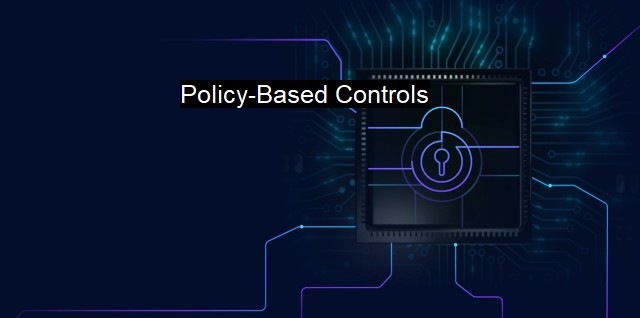What are Policy-Based Controls?
Policy-Based Controls: Strengthening Cybersecurity Measures to Protect Networks, Systems, and Data"
Policy-based controls refer to a set of regulations or guiding principles in a network security system that helps manage and control user interactions and data transmission within the network. The policies dictate who can access what data, establishing a set of rules and protocols to keep the network secure against unauthorized access and other potential security threats. They are an integral component of cybersecurity and antivirus mechanisms, and their scope covers hardware, software, and human interaction.Although the terms "cybersecurity" and "antivirus" are widely used, it is essential to understand that they mean different things. Cyberspace threats are diverse and need a dynamic approach to deal with them effectively. Hence, a distinction is necessary. Cybersecurity is a broad term covering a wide range of strategies, controls, and measures designed to protect networks, devices, programs, and data from cybercrimes, damage, or unauthorized access. It includes procedures such as encryption, authentication, backup, training, and forensic measures.
On the other hand, antivirus is a type of software designed to protect computers from malicious software such as viruses, spyware, ransomware, and other malware. It scans the computer system to identify and neutralize any infected files or software to prevent further damage. It is an element, albeit a vital one, of an exhaustive cyber-security approach.
Policy-based controls encompass various measures and techniques employed to preserve the integrity, confidentiality, and availability of information within a network. In other words, cybersecurity policies are standards established to keep the system secured. They range from determining how passwords are created, changed or updated to specifying the permitted uses of a network.
In terms of functionality, policy-based controls lay down activities like scrutinizing network traffic, recognizing patterns of cyber threats, and reacting to these threats. These principles also include specifics on detecting abnormal user behavior, identifying login failures, and sending alerts for potentially damaging activities. As soon as a threat is detected, the system can either automatically respond, such as by blocking the user or a program, or flag for an administrator's manual intervention.
In addition to system protection, antivirus applications frequently provide controls on manual scanning, real-time scanning, the cleaning of infected files, and the updating of threat definition files. These applications follow protocols established by policy-based controls allowing them to help in detecting malicious software and providing rebuttals.
One of the crucial aspects of policy-based controls lies in policy enforcement. After policies are defined, managers need to ensure that all users adhere to these guidelines consistently. Continuous monitoring tools scan through actions performed on the network to ensure no violations occur.
Policy-based controls also pertain to shielding interactions happening on cloud platforms or telecommunication networks. As businesses increasingly move data to the cloud, the idea behind policies remains the same - authorized access to designated resources.
Policy-based controls are a cardinal element in both cybersecurity and antivirus programming, helping limit potential vulnerabilities. To be effective, these controls ought to be flexible, revisited, and updated periodically. Neglecting them exposes a system to the incessant threat landscape, which then can herald substantial damage including operational interruption, financial loss, breaches of confidential data and reputational damage. Cybersecurity goes beyond having antivirus software; it includes educating employees, implementing comprehensive security practices, and maintaining due diligence to keep a system secured. Meanwhile, an updated antivirus helps to secure hardware and software components from malicious attacks. Together with sound cybersecurity policies, external threats can be mitigically mitigated while fostering a safe, reliable environment for data and network operations.

Policy-Based Controls FAQs
What are policy-based controls?
Policy-based controls are cybersecurity measures that enforce specific policies or rules within an organization's IT environment. These controls are implemented to safeguard an organization's systems, networks, and data from various cyber threats.What is the purpose of policy-based controls in antivirus software?
The purpose of policy-based controls in antivirus software is to help ensure that cybersecurity policies are enforced consistently across an organization's IT environment. These controls can be used to enforce policies related to things like malware detection, software updates, user permissions, and data access, among other things.How are policy-based controls different from traditional antivirus software?
Policy-based controls are different from traditional antivirus software in that they are implemented to enforce specific cybersecurity policies, whereas traditional antivirus software is designed to detect and remove malware from a computer system or network. Policy-based controls may be included as part of an antivirus software suite, or they may be implemented separately using a different software solution.What are some examples of policy-based controls in cybersecurity?
Common examples of policy-based controls in cybersecurity include access control policies, encryption policies, data retention policies, and incident response policies. Access control policies may dictate who has access to certain data or systems within an organization. Encryption policies may require that sensitive data be encrypted at rest or in transit. Data retention policies may govern how long certain types of data are kept, and incident response policies may outline the steps to be taken in the event of a security breach or cyberattack.| | A | | | B | | | C | | | D | | | E | | | F | | | G | | | H | | | I | | | J | | | K | | | L | | | M | |
| | N | | | O | | | P | | | Q | | | R | | | S | | | T | | | U | | | V | | | W | | | X | | | Y | | | Z | |
| | 1 | | | 2 | | | 3 | | | 4 | | | 7 | | | 8 | | |||||||